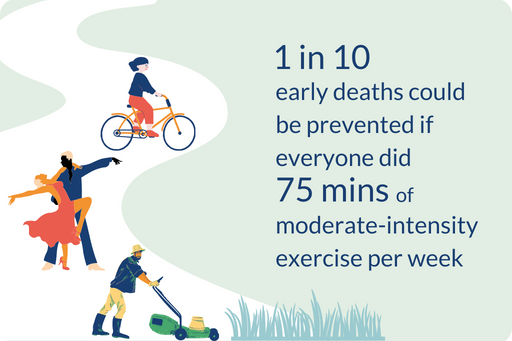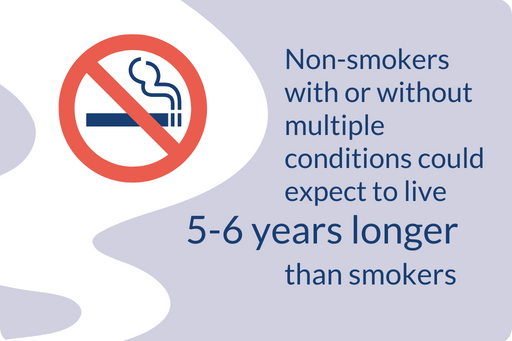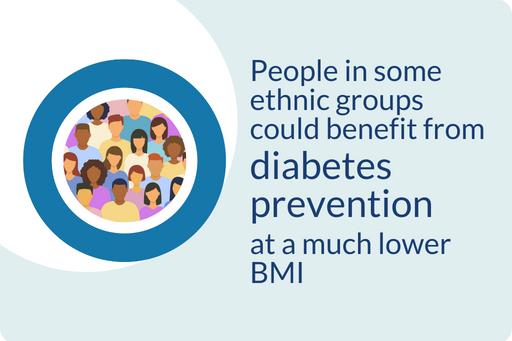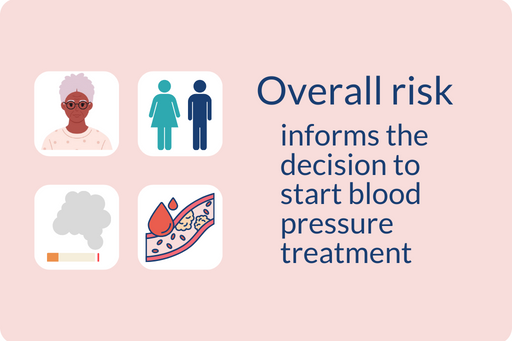Read below to discover 8 research findings addressing key risk factors for poor health in later life, and to help you stay healthy as you age.
Introduction
Too many people spend a large portion of their later life in poor health, much of which could have been prevented. And there are large inequalities across the country.
Risk factors have a strong influence on whether a person becomes ill, at what age, and the associated effect on quality of life. Key risk factors include smoking, being overweight, heavy drinking and physical inactivity, as well as high blood pressure, high cholesterol and diabetes. All of these factors increase the risk of one or more of the leading causes of death: heart disease, dementia, stroke, cancer and lung disease.
The good news is that we can address these risk factors. And the NHS Health Check for people aged 40 to 74 can help identify your risks.
By 2035, more than half the adults in the UK are expected to be aged 50 or over. Currently, people can expect to live longer than previous generations, but are likely to spend more years in poor health. Before the pandemic, for example, a woman in England could expect to live to 83, but spend 19 years in ‘not good’ health. The difference between life expectancy (here 83 years) and healthy life expectancy (here 64 years), highlights why we need to do everything we can to prevent poor health and extend healthy life expectancy.
Prevention of poor health is central to the NHS Long Term Plan and the 2023 Chief Medical Officer’s report, and is a key research priority of the Department of Health and Social Care. It is also a priority for the Government’s upcoming Major Conditions Strategy which promotes a personalised approach to prevention through the management of risk factors.
This Collection brings together a sample of recent NIHR research: 8 studies that all address key risk factors for poor health in later life. Some offer reassurance, for example, about the value of exercise or weight management programmes. Others highlight differences in risk between different groups of people. All studies had important and actionable findings and were therefore featured on NIHR Evidence.
The Collection provides useful information for members of the public, especially those in mid-life, to help them stay healthy as they age. People working in public health and primary care may also be interested. It sits alongside 2 other Collections: one that explores how local authorities’ interventions can reduce obesity, and another about brief conversations in primary care about promoting healthy behaviours.
Addressing key risk factors for poor health – did you know?
1. Even small amounts of exercise protect against early death, cardiovascular disease and cancer
An hour and a quarter per week (11 minutes per day) of moderate-intensity exercise could lower your risk of early death, cardiovascular disease and cancer.

“Making it easy and attractive for people to exercise throughout their lives is one of the most effective ways of maintaining independence into older age.”
Chief Medical Officer’s report 2023: Health in an ageing society
It is well known that regular exercise reduces the risk of early death, cardiovascular disease (conditions affecting the heart or blood vessels, including heart attacks and strokes), and some cancers. This is why the NHS recommends at least 2.5 hours of moderate-intensity exercise per week. This is activity that increases your heart rate and makes you feel warmer. It could be brisk walking, cycling, or dancing, for example. But, until recently, exactly how much exercise is needed to achieve health benefits was unclear.
Researchers analysed 196 research articles, which included data from 30 million adults without pre-existing conditions. They looked at the association between the amount of leisure-time exercise and the risk of early death, cardiovascular disease, and certain cancers.
As expected, more exercise was associated with lower risks of all outcomes. What’s new is that just an hour and a quarter a week (11 minutes a day) of moderate-intensity exercise lowered the risk of an early death, cardiovascular disease, and cancer, compared with no exercise. This is half the recommended amount.
The analysis suggested that 1 in 10 (10%) early deaths could be prevented if everyone did an hour and a quarter of moderate-intensity exercise per week. If everyone did 2.5 hours, 4 in 25 (16%) of these early deaths could be prevented.
“It’s encouraging that this research shows that bite-sized bouts of around 10 minutes of activity each day could have a positive impact on health, reducing the risk of developing cardiovascular diseases. When it comes to keeping active, it’s important to find an exercise routine that works for you, that you enjoy and that you can stick to in the long-term. Whether it’s walking, swimming, or getting outside in the garden – anything that gets your heart beating faster is beneficial.”
Sindy Jodar, Senior Cardiac Nurse, British Heart Foundation

2. The health benefits of weight loss persist even if you regain some weight
People who took part in weight management programmes had reduced blood pressure, cholesterol and blood sugar for at least 5 years, despite weight regain.
In England, almost 2 in 3 adults (64%) are living with obesity or overweight. Obesity and overweight increase the risk of many long-term conditions, including cardiovascular disease, diabetes and cancer. Weight management programmes that address diet and exercise can help people to lose weight in the short-term. However, many people who lose weight on these programmes go on to regain it after the programme finishes.
Researchers recently reviewed 124 trials that followed participants for at least 1 year after the end of a behavioural weight management programme. They explored whether health benefits are maintained despite weight regain.
Those who took part in an intensive weight management programme lost more weight than those who did not. They also had lower blood pressure, cholesterol and blood sugar.
Despite weight regain, this advantage often lasted for at least 5 years, but gradually diminished as weight was regained.
These findings reinforce the value of weight management programmes, and show they can lead to 5 year reductions in risk factors for cardiovascular disease and diabetes. The review can reassure clinicians and members of the public that taking part in weight management programmes and losing weight is worthwhile, even if weight is regained.
“Losing weight can be a difficult, often lifelong, journey. We know that managing a healthy weight is beneficial for our overall health, but gaining weight after making an effort can make us feel defeated. Almost like we’ve done all this hard work for nothing. This encouraging study shows us that even if we gain the weight back, we’ve still done a lot for our heart health.”
Chloe MacArthur, Senior Cardiac Nurse, British Heart Foundation
3. Not smoking can help you live longer, whether or not you have multiple health conditions
At 45 years old, people with multiple conditions could live longer if they have a very healthy lifestyle, especially if they don't smoke.

Smoking, poor diet, physical inactivity and harmful alcohol use are all lifestyle factors that contribute to preventable ill health and early death. For example, every year around 76,000 people in the UK die from smoking.
People with a healthy lifestyle experience many health benefits, including a longer lifespan. But, until recently, it was unclear if people living with multiple long-term conditions also see this benefit. This group of people have poorer health and a higher risk of death compared with others in the population.
Researchers examined long-term health data on almost half a million middle-aged adults. They estimated how many years a healthy lifestyle could add to life expectancy overall. They also looked at the contribution of four lifestyle factors: physical activity, smoking, diet (fruit and vegetables) and alcohol consumption.
The study found that at 45 years old, people with and without multiple conditions can expect to live an extra 6-7 years if they adopt a very healthy, compared to a very unhealthy lifestyle. Smoking had the greatest impact: at 45 years old, non-smokers with or without multiple conditions would be expected to live 5-6 years longer than smokers.
These findings show a healthy lifestyle is equally important for everyone, whether they have multiple conditions or not.
“I have several conditions and I found this research encouraging. It is never too late to improve your life chances! These results could potentially encourage people to take more care of themselves and make healthy choices. There is a clear message to pass on to smokers in particular about the real difference that quitting makes.”
Helen McGregor, Public Contributor, Canterbury

4. Risk of diabetes differs between ethnic groups - could you benefit from diabetes prevention?
White people are at risk of diabetes if their BMI is 30+, but South Asian people with a BMI of 24, and Black Caribbean populations with a BMI of 26, have a similar risk.
Around 2 million people in England are at risk of developing type 2 diabetes. This increases the risk of cardiovascular disease and cancer, and can lead to long-term complications including sight loss, foot and kidney problems. However, lifestyle changes such as weight management and physical activity can prevent diabetes in many people.
Body mass index (BMI) is closely linked to type 2 diabetes but has different effects on different groups of people. Recent research detailed the BMI values which increase the risk of diabetes in different ethnic groups.
The study used data on almost 1.5 million adults who had not been diagnosed with type 2 diabetes. Their records included ethnicity and BMI. Researchers measured how often white people with a BMI of 30 (NHS definition of obesity) were diagnosed with type 2 diabetes. They then calculated the BMI in South Asian, Arab, Chinese and black populations that gave the same risk of diabetes.
People of all ethnicities (other than white) were at risk of diabetes with a BMI lower than 30. In some groups, it was much lower. For example, South Asian people with a BMI of 24 were found to be at risk of diabetes. The same BMI would be considered healthy in a white population.
The study was large enough to look in detail at South Asian and black populations. It suggested that diabetes prevention is needed at BMI values as low as 21 in people of Bangladeshi heritage, and 26 for Black Caribbean populations. A more personalised approach to prevention could help prevent many people in these populations from developing type 2 diabetes.
“It is vital that everyone with, or at risk of, type 2 diabetes receives the best possible care, and this important research adds to evidence suggesting that setting different BMI cut-offs for obesity according to people’s ethnicity could give more people a better chance of preventing type 2 diabetes or getting diagnosed early.”
Esther Walden, Senior Clinical Advisor at Diabetes UK
5. Women who carry extra weight around their middle could be at greater risk of dementia
People aged 50+ who were living with obesity, were 31% more likely than others to have dementia 11 years later. Women with excess weight around their waistline were at particular risk.

Dementia is one of the major health challenges of the 21st century. The most common cause is Alzheimer’s disease. Dementia and Alzheimer’s disease account for around 66,500 deaths a year in England and Wales, and rates are expected to rise as the population ages. Risk factors that can be modified include high blood pressure, physical inactivity, smoking, excessive alcohol consumption and diabetes. Obesity is also believed to be one of these factors but the results of previous studies have been mixed.
To address the uncertainty, researchers analysed data on more than 6500 people aged 50 or over who were free of dementia, and followed them for an average of 11 years. They accounted for age, smoking behaviour, diabetes, blood pressure, and other factors and examined the link between obesity and dementia.
They found that people living with obesity at the start of the study were 31% more likely to develop dementia than those of a healthy weight. Women who carried extra weight around their waistline were particularly vulnerable; they had a 39% increased risk of dementia.
Obesity rates are rising. This study provides another reason for encouraging and supporting people to maintain a healthy weight.
“This research adds to growing evidence that managing risk factors and optimising lifestyle interventions may protect against developing dementia disorders in later life. Wider acceptance of the message through targeted educational interventions directed both at professionals and the public is needed.”
Naji Tabet, Professor of Dementia and Old Age Psychiatry, Brighton and Sussex Medical School

6. Blood pressure treatment decisions are best guided by your overall risk
Overall risk of cardiovascular disease (based on age, gender, cholesterol, smoking status, and other factors) indicates the need for blood pressure medicines more accurately than blood pressure alone.
Cardiovascular disease accounts for 1 in 4 early deaths in England each year. High blood pressure is a key risk factor. UK guidelines now recommend that, in addition to someone’s blood pressure, their overall cardiovascular risk should inform the decision to start drug treatment for high blood pressure. However, in practice, blood pressure readings often drive the decision to start medication. Medication is usually started when someone’s blood pressure is above a standard threshold (of 140/90 mm Hg).
Recent research explored the importance of overall risk compared to blood pressure alone at predicting a cardiovascular event (such as a heart attack or stroke).
The study involved data from more than 1 million people, with an average age of 52 at the start of the study. Their overall cardiovascular risk was measured with a well-known tool called QRISK2. It combines information on age, gender, ethnicity, cholesterol, weight, smoking status, family history of heart disease, and other medical conditions, as well as blood pressure.
The researchers found that cardiovascular events were more accurately predicted by overall risk, than by blood pressure alone. Overall risk indicated the need for blood pressure medicines more accurately than blood pressure alone.
The findings suggest that overall risk should drive blood pressure management. They highlight the importance of reducing overall risk, through lowering cholesterol, maintaining a healthy weight or stopping smoking, for example.
“I have been taking blood pressure medication and statins for many years and I found this research both reassuring and concerning. I was placed on these medications because my risk scores were high. I am diligent at taking my medication and my blood pressure is well-controlled. This has given me a level of reassurance that may not be wholly justified. I am happy to continue with my medication, but it is a wake-up call for me to see the effect of other factors in the predicted risk score, which I have become a little complacent about.”
Peter Green, Public Contributor, Sunderland
7. Statins for high cholesterol do not commonly cause muscle pain and stiffness
Statins were no more likely than placebo to cause troubling muscle symptoms such as pain, cramp and stiffness.

A high level of cholesterol in the blood increases the risk of cardiovascular disease. Statins are a group of drugs which lower cholesterol levels and reduce the risk of heart attacks and stroke. In 2022 alone, more than 9.5 million patients were dispensed a statin in the UK. However, some people stop taking statins after reading negative stories in the media.
Concern about muscle pain is one of the most common reasons for not taking statins. Research investigated whether statins could cause troubling muscle symptoms such as pain, cramp and stiffness. These symptoms are common in the general population, especially as people get older.
The study included 200 people who had all stopped, or were considering stopping, taking statins because of concerns over muscle symptoms. Each participant spent half the study taking a daily statin (atorvastatin), and half taking an identical-looking placebo pill. They never knew which they were taking.
The results showed there was no difference in the number or severity of muscle symptoms whether people were taking statins or placebo. At the end of the study, participants were given their own results and most (88%) found them helpful. Two in three (66%) intended to resume taking statins.
Statins are safe and effective but need to be taken long-term to reduce the risk of heart attacks or strokes. This study’s findings could reassure people who have been recommended statins, that aches and pains are as common with placebo as with statins. This could encourage them to continue taking the medication.
“There is a lot of concern out there that statins commonly cause muscle aches. However, muscle aches are common, and when this concern is tested properly, as was done in this trial, the results clearly show that most muscle aches attributed to statins are not due to the drug. I hope this trial provides confidence to patients to take a statin when this is recommended to them by their doctor.” Nilesh Samani, Medical Director, British Heart Foundation

8. Using local parks and open spaces can improve your wellbeing
Aspects of where you live, such as housing conditions and your sense of belonging, relate to wellbeing; use of local parks and open spaces was most strongly linked.
Wellbeing is about feeling good and functioning well. It includes happiness, purpose and control over your life choices. The effect of wellbeing on health is substantial and comparable to other risk factors more traditionally targeted by public health, such as a healthy diet. For example, it is estimated that high levels of wellbeing can add 4 to 10 years to a person’s life compared to low levels of wellbeing.
A study involving 4319 adults recently explored how individual factors (such as their health, finances and marital status) and place factors (such as housing conditions, access to open space, and feeling involved in decisions about the community) are related to wellbeing.
The research showed that while individual factors were more strongly linked to wellbeing, place factors had an impact. Use of local parks, open spaces and recreation areas were more strongly associated with wellbeing than any other place factor. A sense of belonging within the community was also important.
Greenspaces are increasingly recognised for promoting and protecting good health, aiding recovery from illness and helping manage poor health. This study emphasises that using greenspaces may protect people’s wellbeing.
“The importance of local social support networks and access to open spaces both came to the fore during the pandemic as important influences on our wellbeing. At the What Works Centre for Wellbeing we champion this study’s exploration of the complex interrelationship between individual and community wellbeing. We look forward to seeing more research build upon it, expanding the evidence base further still.”
Stewart Martin, Community Wellbeing Lead, What Works Centre for Wellbeing
Conclusion
The 8 examples of recent research in this Collection offer insights and encouragement for members of the public trying to stay healthy as they age.
It can be difficult to reduce risk factors. Many people find it challenging to do the recommended amount of exercise, and hard-earned weight loss is often followed by weight regain. Research in this Collection offers reassurance. Even small amounts of exercise protect your health, and the health benefits of losing weight remain even if weight is regained. People prescribed statins to reduce their cholesterol can also be reassured; these drugs do not commonly cause muscle pain and stiffness.
Different groups of people are at different risks for the same health condition. Research in this Collection shows how ethnicity influences someone’s risk of diabetes. Also, that women could be at a greater risk of dementia if they carry weight around their middle. A more personalised approach to prevention could be built on evidence like this.
Collective action spanning public health, health and social care, economic and social conditions could extend life expectancy across the population. But the NHS Long-Term Plan recognises the need for tailored prevention for different individuals, alongside action across the whole of society. With the right support, people of all ages can better manage their physical and mental wellbeing. Addressing the risk factors that drive the burden of preventable ill health and early death is just one approach, but it could make a real difference. As evidenced here, adopting a healthy lifestyle in middle age could add 6-7 years to your life.
Author: Jemma Kwint, Senior Research Fellow, NIHR Evidence
How to cite this Collection: NIHR Evidence; 8 findings to help you stay healthy as you age; November 2023; doi: 10.3310/nihrevidence_60480
Disclaimer: This Collection is based on research which is funded or supported by the NIHR. It is not a substitute for professional healthcare advice. Please note that views expressed are those of the author(s) and reviewer(s) at the time of publication. They do not necessarily reflect the views of the NHS, the NIHR or the Department of Health and Social Care.